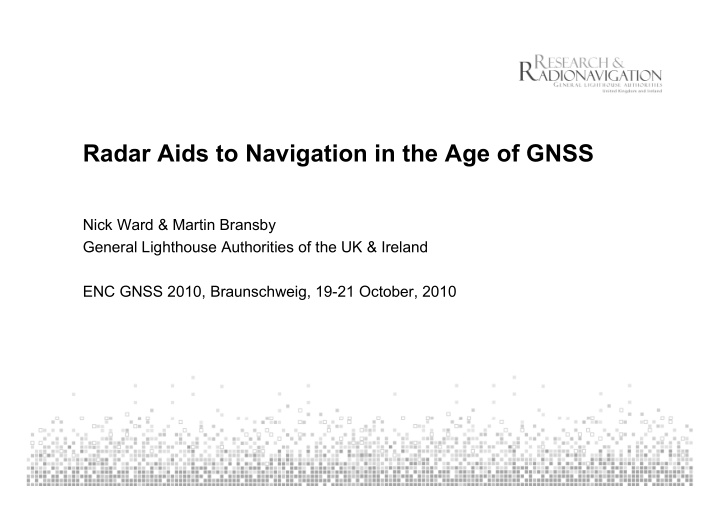



Radar Aids to Navigation in the Age of GNSS Nick Ward & Martin Bransby General Lighthouse Authorities of the UK & Ireland ENC GNSS 2010, Braunschweig, 19-21 October, 2010
Introduction � GNSS has become the primary means of navigation for commercial shipping, fishing and leisure craft � Radar retains its primary role in collision avoidance and radar beacons (racons) are still a valuable aid to navigation � IMO has removed the requirement for S-band radar to trigger radar beacons (racons) � To encourage development of low power, solid-state, cost- effective radars using DSP (NT Radar)
NT radar Conventional Radar New Technology Radar non-coherent coherent pulsed CW/FM high peak power (3-30 kW) low peak power (10-500 W) Resonant cavity (e.g. magnetrons) solid-state
So is there still a role for Racons? Surveys of mariners have indicated that racons are still valued as an aid to � navigation � Racons are independent of GNSS S Band (3 GHz) radar is often the preferred device for detecting targets � that could present a collision or grounding risk � X Band (9 GHz) gives better resolution, but performance is poor in clutter conditions � If S Band NT radars deliver the performance improvements promised, X Band is likely to go the same way, although not for a few years
What are the options? � Use existing racons and accept a loss of performance � Modify existing racons to improve performance with NT � Develop NT racons � Replace with different technology (AIS?) � The GLA have carried out trials to assess the performance of racons with S Band NT radar
Racon trials � To determine performance of S band racons (2.9-3.1 GHz) with a commercially available NT radar, compared with a conventional, magnetron-based X band radar (9.3-9.5 GHz) � Racons were observed as the vessel approached and departed from them up to their maximum operational ranges � Clarity of response and ability to identify codes were recorded at approximately 1 NM intervals on both NT S Band and conventional X Band radars. Second trial was carried out to resolve anomalous results from the earlier � trial
Results Band S X Racon max range (NM) max range (NM) A 4.5 12 B 5 14 C 5 12 D 5 8 E 3 9 F 10 12
Spurious returns from Racon F installed on Wicklow Pier
Correct return from Racon F, but obscured by land clutter
Spoking observed from Racon F at Wicklow
Racon F response at 9 NM
Return from Racon C at Wicklow
Racon E on Arklow buoy
Racon E and windfarm responses
Racon D on Codling Lanby
Racon B on Kish LH
Racon A on Dublin Bay Buoy
Trial conclusions 1. The NT Radar tested did trigger racons, but at substantially reduced range (generally less than 5 NM). 2. A new version of one of the racons tested gave up to 10 NM range at S Band, almost certainly because of its improved receiver sensitivity (+ 10 dB over original settings). 3. The inconsistencies in responses of some racons in the earlier trial, were resolved. 4. The ranges with a conventional X Band radar were generally much better, around 10 NM and clarity of response was much greater, except at close ranges in clutter.
Where do we go from here? 1. Modification of existing racons to improve their response to NT radars to be considered in consultation with racon manufacturers. 2. Modifications could include: increasing the receive sensitivity, removing the scalable response, designing the racon to detect, and respond differently to NT radar. 3. Differences in racon performance during these trials indicate that better standardisation of racons should be considered. 4. IALA has been informed of trial results to guide strategy for future of racons. 5. Investigate absolute positioning using radar AtoNs as a potential backup to GNSS
Radar positioning as a backup to GNSS � Passive/active reflectors � Radar beacons � Need for identification Accuracy of fix (range/bearing) � � Site selection (height, location, clear field of view) Feasibility & cost �
Feasibility & costs � Some AtoNs already present good radar targets and have racons � Others on low-lying coastlines would need enhancement � How many sites needed? � Need to use existing sites
Feasibility & cost � Changes to onboard equipment � Trivial calculation � Need to standardise Demonstrate benefits � � Trials to prove accuracy
Acknowledgements The authors wish to acknowledge the cooperation and support of the Captain and crew of CIL Tender Granuaile and the organisation provided by the CIL Marine and Engineering Departments. The participation of Capt. Roger Barker (THLS) and Peter Douglas (NLB), the NT radar manufacturer Kelvin Hughes and consultant Prof Andy Norris in the earlier trial was also very valuable. Prof Norris has also been involved in the development of the concept of positioning using radar AtoNs.
More information nick.ward@gla-rrnav.org
Recommend
More recommend